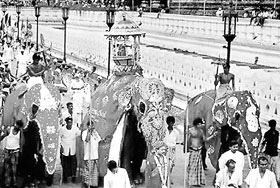Festival time is about to begin in Kandy, the hill capital. The annual Esala pageant – commonly known as the Esala Perahera – commences on Wednesday 22nd with the 'kap situvima' – the traditional custom of planting a branch of either a jak or a
'rukattana' tree as a vow that the Perahera be held
without any mishap. This is done at the four
'dewales' – Natha, Maha Vishnu, Kataragama and Pattini which are located in and around the Dalada Maligawa.
For Buddhists, the 'Sri Dalada' – the sacred Tooth Relic of the Buddha – is the greatest object of worship. The Relic is treated with utmost respect and veneration just as much as the Buddha if he was living. It's in
honour of the Sri Dalada that the annual Dalada Perahera is held, following centuries of tradition when the Relic was taken in procession viewed by the masses.
After the 'kap situvima', until the Perahera proper begins after five days, a mini-procession is held every evening at the premises of each 'dewale'. It is a simple procession round the 'kap' which has been planted with only those involved with rituals of the 'dewale' taking part. The 'kapurala' – the lay official at each 'dewale'
carries a golden weapon ('ran aayudhaya') said to have been used in battle by the deity of the 'dewale' .
On the sixth evening, the 'Kumbal Perahera' begins and goes on for five nights. This year the 'Kumbal Perahera' will be from July 27 – 31.
With the Kumbal Perahera, the procession leaves the 'dewale' premises and parades through a number of streets in the city. The Maligawa Perahera also joins the four 'dewale' processions. The temple chiefs wear their traditional white Kandyan court dress to walk in the Kumbal Perahera. The number of elephants increases every night and the grandeur of the Perahera gradually takes shape.
The grand show begins after another five nights when the 'Randoli Perahera' starts. 'Randoli' means
'Queen's Palanquin' reminding of a tradition when
palanquins were carried alongside the elephants at the Perahera. This was changed by King Kirti Sri Rajasinghe in 1775, who wanted the palanquins to be brought at the end of the Perahera. This was possibly because females were not permitted to march alongside the Tooth Relic.
The tradition of taking the palanquins at the end of the Perahera continues to this day.
Records indicate that the king himself marched in the Randoli Perahera. Now the Diyawadana Nilame – the lay custodian of the Tooth Relic, clad in his highly decorated official dress and head gear, walks along with several Nilames also dressed in their official garb.
This year the Randoli Perahera starts on August 1st and continues till the 5th. The final night is always the most glamorous when the annual pageant reaches its zenith.
The Perahera comes to a close on August 6th when after five nights of the Randoli Perahera, the water cutting
ceremony takes place at Getambe followed by the Day Perahera.
Crowds flock to Kandy from all parts of the country to watch the Perahera. It is also a big attraction for the foreign tourists. Many agree that it is unique with such a galaxy of caparisoned elephants, dance troupes performing age-old Kandyan dances, groups of drummers, 'kasa karuvo' – whip crackers who announce the arrival of the Perahera, flag bearers carrying the standards of the different provinces and temples, and Maligawa officials in-charge of different functions.
The Maligawa Tusker carrying the relic casket is the cynosure of all eyes. A canopy is held over the Tusker and 'pavada' (white cloth) is spread on the path for it to walk on. This is done as a mark of respect. The Tusker is followed by two lines of dancers facing each other on either side of the road with drummers in the centre.
The Diyawadana Nilame walks at the end of the retinue. The 'dewale' processions
follow the Maligawa Perahera. |

